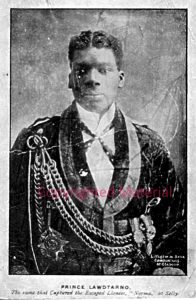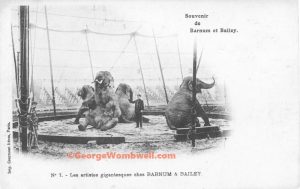
E H Bostock probably with Dixie the elephant around 1932

Prince LawdTanno (Spell) known to have been travelling with a menagerie and circus around 1905. Probably a lion tamer modelled on Montarno the African Lion King. Known to have travelled with Chipperfield’s French Menagerie during the early twentieth century.

Waggon containig two lions and possibly a seated trainer or keeper, also at Selby circa 1930. Not a typical B&W waggon, so it is also probably a Sanger outfit.
The following photographs have been sent to us for dating and for any other information. I have added my comments underneath each photograph, but would welcome further information via the comments section at the bottom of the post or via email: shaun.everett1@gmail.com
Thank you for your interest in this project about the local history of Selby in Yorkshire. My thanks to Mr Chilvers for providing the original photographs.

Rare view of B&W booth at Selby during 1931. This must have been one of the last times it visited the town or anywhere else, given it disbanded the following year. Shows the poor condition of the booth front.

At Selby, showing a group of Dancing Bears on the left of the picture performing for the local population. Unknown group and date. Information would be welcome.


 The postcard is much later of course and some ‘granny’ must have received it hand delivered!
The postcard is much later of course and some ‘granny’ must have received it hand delivered!

 The card was sent from Brussels during 1904 or it may be 1922-23. I’m no philatelist! Research is required to place this troupe in the history of entertainment and identity studies.
The card was sent from Brussels during 1904 or it may be 1922-23. I’m no philatelist! Research is required to place this troupe in the history of entertainment and identity studies.


 “Lord” George Sanger had died many years before, but his circus travelled till 1941 when it was broken up due to food rationing, a ban on performing animals(in case they escaped during an air raid!) as well as labour shortages.
“Lord” George Sanger had died many years before, but his circus travelled till 1941 when it was broken up due to food rationing, a ban on performing animals(in case they escaped during an air raid!) as well as labour shortages. Generally, showmen coupled several horses to their carriages on such parades. Wombwell is known to have coupled up to eight horses to a carriage on at least one occasion.
Generally, showmen coupled several horses to their carriages on such parades. Wombwell is known to have coupled up to eight horses to a carriage on at least one occasion. Published today, a history of the Lion Queens that became famous in the 19th century world of traveling menageries and circuses. One of the most famous is Ellen Chapman, here depicted by Horner with wild beasts. The works are oil on canvas and are a pendant pair. Last known at auction in 2000. This is the last in our series on Lion Kings and Queens.
Published today, a history of the Lion Queens that became famous in the 19th century world of traveling menageries and circuses. One of the most famous is Ellen Chapman, here depicted by Horner with wild beasts. The works are oil on canvas and are a pendant pair. Last known at auction in 2000. This is the last in our series on Lion Kings and Queens.